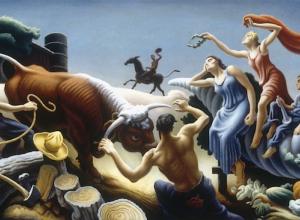At its height in the 1920s and 30s, Precisionism borrowed from Cubism and Futurism to create its own Modernist vision. Sometimes called “Immaculates” for their detailed style of painting, these artists excelled at depicting the gleaming metals of industrialization. Though their reverence for modern marvels and urbanity is a common subject matter, this aesthetic was also applied to still lifes, pastoral scenes, and abstractions. Prominent Precisionists include Stuart Davis, Charles Demuth, Charles Sheeler, and at times Georgia O’Keeffe. Working in a palate of steely greys, they captured a specific moment in American history, when spires of skyscrapers and glistening metal machinery was awe-inspiring and a source of national pride.

Clarence Holbrook Carter, "War Bride," 1940. Oil on canvas, 36 x 54 in. (91.4 x 137.2 cm). Carnegie Museum of Art, Pittsburgh, Richard M. Scaife American Painting Fund and Paintings Acquisition Fund, 82.6.
Opening this month at the de Young in San Francisco is “Cult of the Machine: Precisionism and American Art.” This comprehensive survey of America’s first homegrown art movement showcases art of the machine age. Known for its clean lines and smooth surfaces, these works celebrated the industrial age and presented a distinctly American point of view. Including decorative arts in addition to painting and photography, "Cult of the Machine" gives an in-depth and scholarly view of this movement that has not seen a major exhibition in 20 years.

Elsie Driggs, "Aeroplane," 1928. Oil on canvas, 44 x 38 in. (111.8 x 96.5 cm) The Museum of Fine Arts, Houston, Museum purchase funded by the Brown Foundation Accessions Endowment Fund, 2006.297.
“Cult of the Machine” is on view at the de Young through August 12. The exhibition will then travel to the Dallas Museum of Art, where it will be on view from September 9, 2018, through January 6, 2019. For more information visit http://deyoung.famsf.org/exhibitions/cult-machine





























